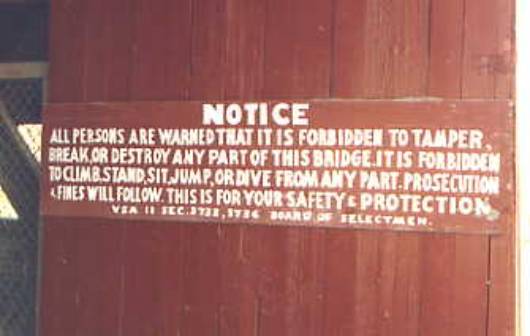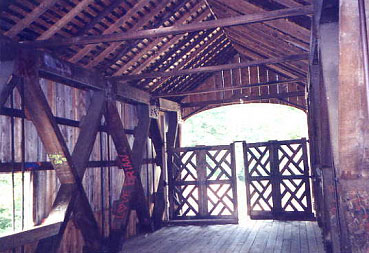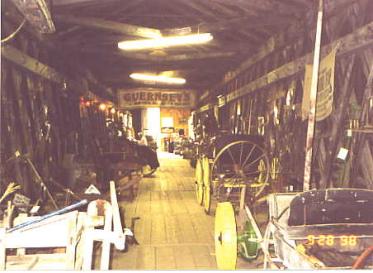U.S. Department of Transportation
Federal Highway Administration
1200 New Jersey Avenue, SE
Washington, DC 20590
202-366-4000
Federal Highway Administration Research and Technology
Coordinating, Developing, and Delivering Highway Transportation Innovations
 |
| This report is an archived publication and may contain dated technical, contact, and link information |
|
Federal Highway Administration > Publications > Research > Structures > Covered Bridge Manual |
Publication Number: FHWA-HRT-04-098 |
Previous | Table of Contents | Next
A number of agencies are involved with regulating and providing guidance for historic preservation. Proposed work on covered bridges must satisfy each of these entities and conform to several aspects of historic preservation. Further, owners of covered bridges are often especially protective of these treasures, as evidenced by the sign in figure 168.

Figure 168. Bridge at the Green, Arlington, VT.
One of the most important historic preservation issues for work with covered bridges is the National Register of Historic Places. A good reference for information about this topic is provided on the National Park Service's Web site, http://www.nps.gov.
Not all historic covered bridges are listed on the National Register, but most people involved in this aspect of historic preservation believe that most extant covered bridges are eligible to be listed, meaning that they would be listed if the effort were made to follow the application process. Therefore, whether a particular bridge is on the National Register or not does not matter, because most owners and/or funding agencies do not advocate destroying historic covered bridges.
Being listed on the National Register carries with it limitations regarding what actions are possible when considering rehabilitation. There are certain preferred means and methods to rehabilitating historic covered bridges, as described later in this chapter in the section, "Secretary of Interior's Standards for Historic Preservation."
The National Register's listing process is provided on the National Parks Service Web site. There is also a Register of Historic Places in most States, in addition to the National Register. The distinctions between being listed on one or both depends on the State.
Established in 1969, in cooperation with ASCE and the Library of Congress, the Historic American Engineering Record (HAER) is a National Park Service program responsible for compiling a national archive of America's engineering, industrial, and technological achievements of historic interest. The collection contains nearly 3,500 sheets of measured and interpretive drawings, 72,000 large-format photographs, 61,000 data pages, and 1,000 color transparencies on more than 7,000 sites, structures, and objects. The collection is curated and made available to the public by the U.S. Library of Congress; it is also one of the first available online as part of the National Digital Library (http://memory.loc.gov/ammem/collections/habs_haer/). The collection includes documentation on more than 100 covered bridges.
HAER, in cooperation with FHWA, is conducting a 3-year project to complete documentation on a selection of America's outstanding covered bridges. In addition to HAER documentation, it is proposed that a selection of bridges will be nominated as National Historic Landmarks, a traveling exhibit is planned, a best practices workshop was held at the University of Vermont, June 5-7, 2003, and a Web page for covered bridges is planned.
In practice, there are varying degrees of interest, knowledge, and interpretation of National Register issues in the various State Historic Preservation Offices. For example, some may believe that it is acceptable to allow floor systems to be removed from extant bridges and replaced by an independent floor system, while others would not tolerate such an act. Therefore, it is important to coordinate with the State office for the project under consideration. Further, it is particularly important to initiate contact with that office early in the project to identify special interests or concerns.
Some projects include unusual features deserving special consideration by the State office, like these ornate timber gates used to restrict this bridge to pedestrians and bicycles (see figure 169).

Figure 169. Comstock Bridge, East Hampton, CT
The Advisory Council on Historic Preservation is an independent Federal agency that provides a forum for influencing Federal activities, programs, and policies as they affect historic resources. The goal of the National Historic Preservation Act (NHPA), which established the Council in 1966, is for Federal agencies to be responsible stewards of our Nation's resources when actions affect historic properties. The Council is the only entity with the legal responsibility to balance historic preservation concerns with Federal project requirements.
As directed by NHPA, the Council:
The Advisory Council normally is not involved directly in establishing the goals of a particular covered bridge preservation project. Instead, the State Historic Preservation Office coordinates with the Council as necessary.
Some historic structures have been converted for unusual use, leading to interesting evaluations of proposed projects. Figure 170 depicts an example of what some historic covered bridges are used for after serving their useful life for vehicular traffic. This is the museum inside the Shushan Bridge in Washington County, NY.

Figure 170. Museum at Shushan Bridge-Washington County, NY.
The U.S. Secretary of the Interior developed "Standards and Guidelines for Archeology and Historic Preservation" under the authority of Sections 101(f), (g), and (h), and Section 110 of the National Historic Preservation Act of 1966 (http://www.nps.gov/history/local-law/arch_stnds_0.htm). These standards and guidelines are not regulatory and do not set or interpret Agency policy. They are intended to provide technical advice about archeological and historic preservation activities and methods.
A good reference for these standards is summarized on an Internet site hosted by the Advisory Council on Historic Preservation at: http://www.achp.gov/106course-resources.html. An important distinction is made among various types of anticipated preservation work-rehabilitation, reconstruction, and restoration.
As taken directly from that site:
Rehabilitation (treatment)-the act or process of returning a property to a state of utility through repair or alteration which makes possible an efficient contemporary use while preserving those portions or features of the property which are significant to its historical, architectural, and cultural values.
Reconstruction (treatment)-the act or process of reproducing by new construction the exact form and detail of a vanished building, structure, or object, or any part thereof, as it appeared at a specific period of time.
Restoration-the act or process of accurately recovering the form and details of a property and its setting as it appeared at a particular period of time by means of the removal of later work or by the replacement of missing earlier work.
In brief, restoration and reconstruction are preservation actions that focus on the preservation with less consideration of the structural needs of the work. Rehabilitation allows less intensive preservation and more consideration of structural needs.
For covered bridges that vehicles continue to use, the structural demands often require strengthening that alters the original construction. That type of work usually involves rehabilitation rather than restoration. Consequently, rehabilitation may result in retaining less original fabric.
There is controversy as to what makes a covered bridge historic. Some believe a bridge is important because it is a physical relic and the material is historic. Some believe that a covered bridge is historic because it embodies a special idea or concept. As noted elsewhere in this manual, various components of an historic covered bridge have probably been replaced at least once during its life (e.g., roofing, siding, flooring); hence, some believe that replacing those items in subsequent repair projects is acceptable. Others place more emphasis on replacement in-kind and only when necessary.
The decision regarding the type of preservation treatment for a given bridge is, therefore, complex and should be made in consultation with the various stakeholders involved-owners, engineers, and State Historic Preservation Officers (or designated representatives), at a minimum.
The engineer's input is vital to establish what work may be necessary for a given desired end. Including one or more local contractors who are experienced with authentic covered bridge work is critical in the early planning process to ensure the project's success. Contractors interested in the work on the particular project may not want to jeopardize their potential award of the work due to a perceived conflict of interest.
The National Park Service also sponsors the Historic Preservation Training Center (HPTC) in Frederick, MD. The HPTC is devoted to preserving and maintaining historic structures. The center is working to produce best practices guidelines for covered bridges based on the U.S. Secretary of the Interior's Standards.